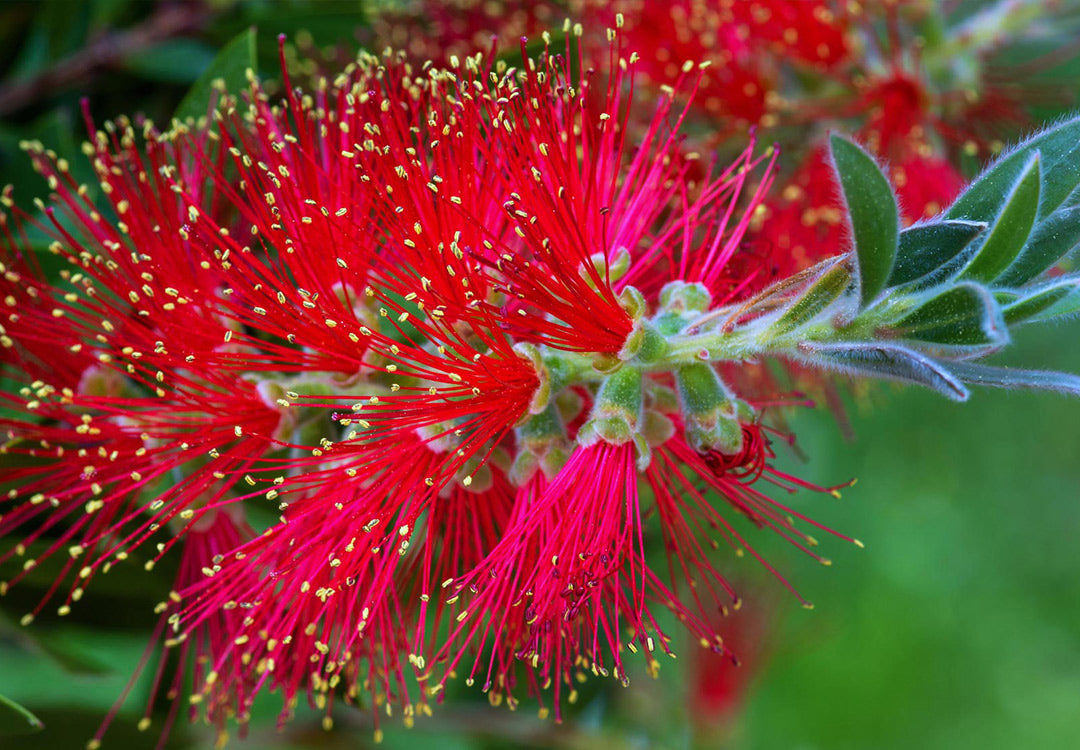
Bottle brushes are in the Myrtaceae family along with eucalypts and lilly pillies.
It’s contended whether or not Callistemon group is worthy of being described as a separate genus from the Melaluca group due to the fact that they are very similar. Because of this, they’ve been combined into a single post here.
These plants are full of camphoraceous essetial oils and are responsible for tea tree oil. They also produce a nectar that attracts pollinators such as insects, birds and possums.
Bottle brushes traditionally refer to callistemons, even though maleleucas do have a bottle brush inflorescence as well, or alternatively maleleucas can have a globular (ball-shaped) inflorescences. Maleleucas are often called paper barks or honey myrtles.
Description
These plants are woody trees, shrubs or shrubby trees that have a distinctive inflorescence that resembles a bottle brush. Bark can be rough, stringy or papery.
The flowers usually form laterally on the branch and leave the apical tip to continue growing, although sometimes to aborting, or terminating the branch.
Flowers, Fruits & Leaves
Sepals & Petals: 5 small sepals and 5 small petals are hard to distinguish among the conspicuous fuzzy stamina.
Male: Countless stamina are the highlight of each flower. In Callistemon sp. the stamens are generally separate and free, whereas in Maleleuca sp. several stamens are united together at the base.
Female: Usually there is one pistil present.
Fruit & Seeds: The seed pod is similar to a gum nut and contains countless tiny seeds. Pods remain attached to the branch for years in the same formation as the inflorescence. Seeds may be released soon after maturing, or several years later.
Leaves: Stiff, flat leaves are alternate in a spiral and may or may not have hair.
Noteworthy Types
Callistemon citrinus is one of the classic types that most people get in their backyard. They are usually crimson, but the popular ‘White Anzac’ cultivar has white inflorescences.

Callistemon sp. (probably C. citrinus) with a bottle brush inflorescence near the branch tip. Image source

Callistemon sp. seed pods attached to the branch. Image source

Mature Callistemon citrinus with bark looking a bit like an iron bark. Image source

A young Callistemon citrinus bush in flower. Image source
Melaleuca quinquenervia is famous for its papery bark, lending to its colloquial name, paper bark. There are other plants that can be called paper barks as well, within this plant group and within other clades.

Paperbark Melaleuca quinquenervia inflorescence. Image source

The papery bark on a Melaleuca quinquenervia. Image source
Conclusion
Whether they’re reclassified into a single genus or not, it’s worth knowing that these two types of plants have a lot in common with their fuzzy bottle brush inflorescences.
If you haven’t already read my articles on plant identification and scientific names, I recommend reading those to get a broader picture of the topic. Alternatively, you can browse some of my other plant families, subfamilies and genera below.
